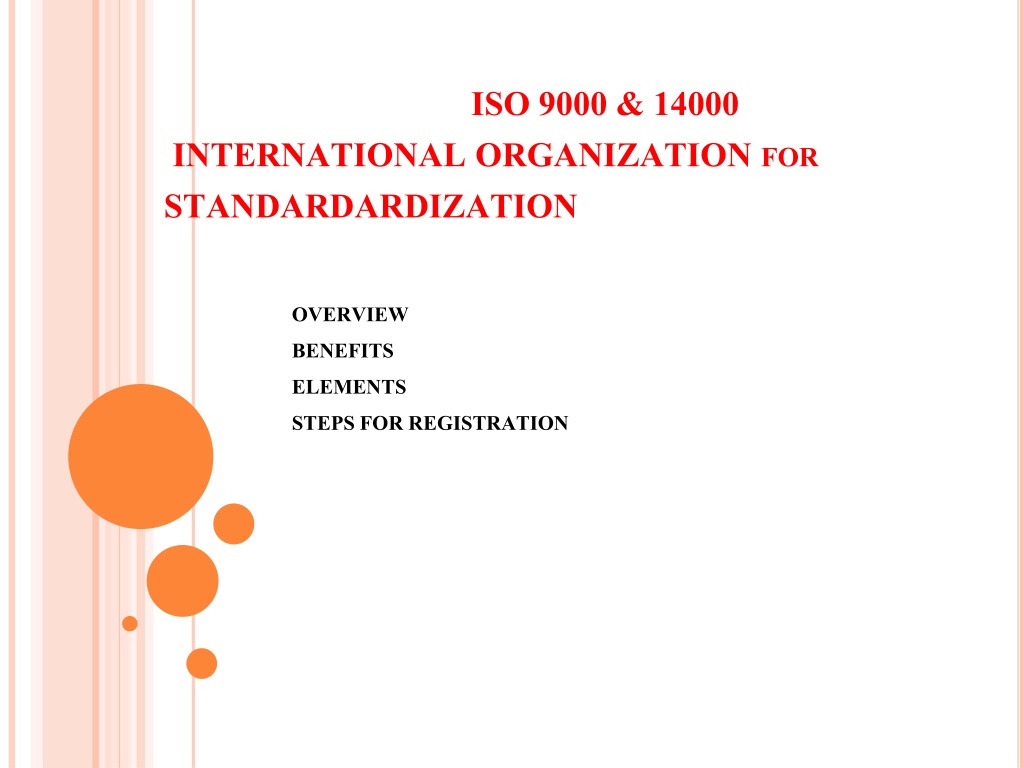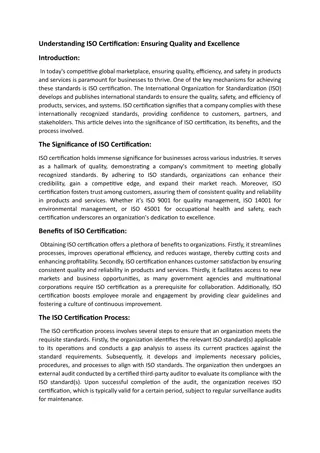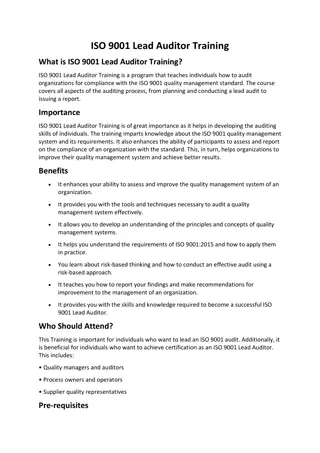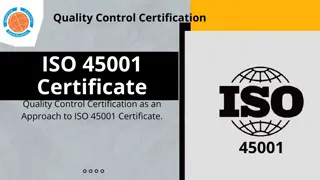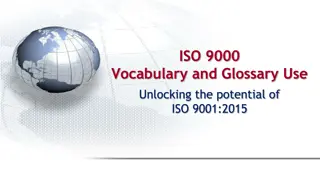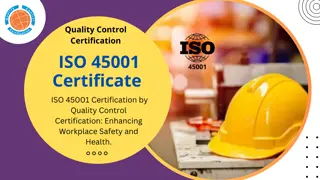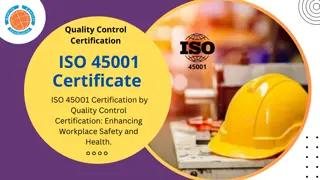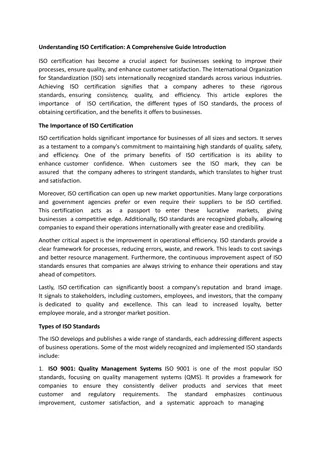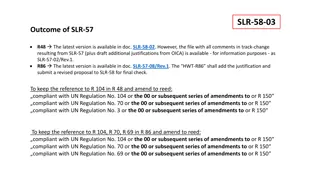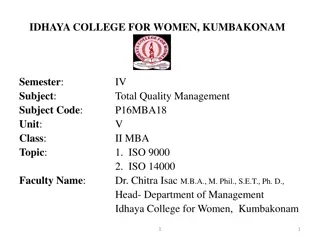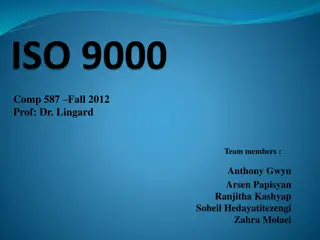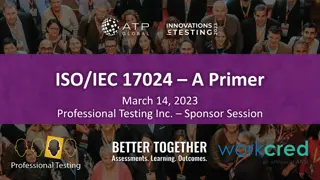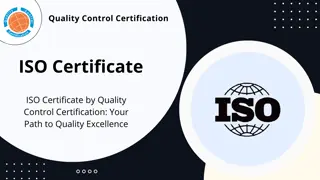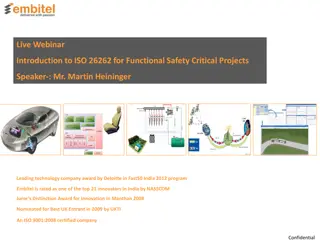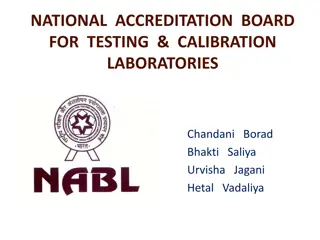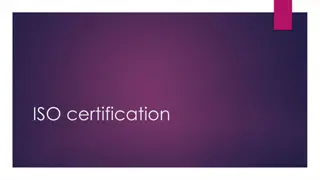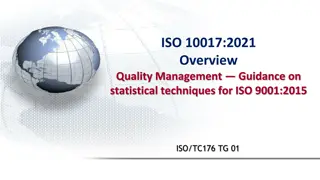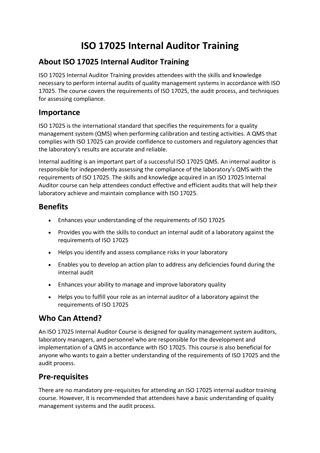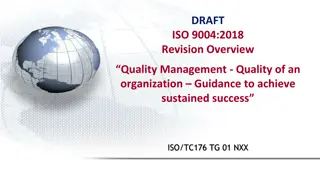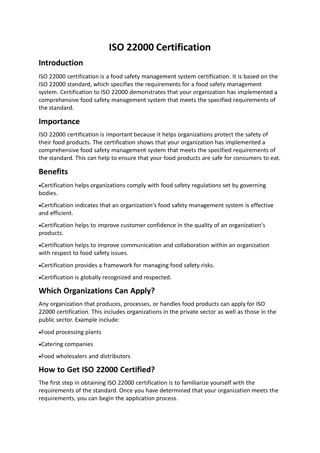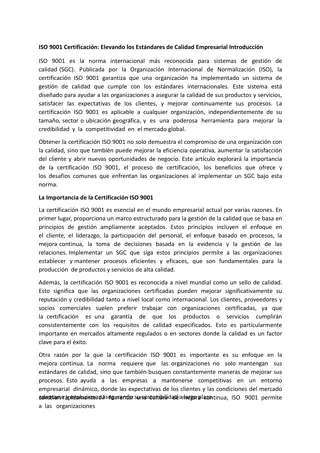Understanding ISO 9000 and 14000 Standards for Quality Management
ISO 9000 and 14000 are international standards developed by the International Organization for Standardization to establish and maintain effective quality management systems. They provide guidelines for quality audits, monitoring, and continuous improvement for businesses in various industries. Complying with these standards can lead to improved controls, customer satisfaction, and trade liberalization, while reducing errors, costs, and redundant procedures.
- ISO standards
- Quality management
- International Organization for Standardization
- Continuous improvement
- Quality audits
Download Presentation

Please find below an Image/Link to download the presentation.
The content on the website is provided AS IS for your information and personal use only. It may not be sold, licensed, or shared on other websites without obtaining consent from the author. Download presentation by click this link. If you encounter any issues during the download, it is possible that the publisher has removed the file from their server.
E N D
Presentation Transcript
ISO 9000 & 14000 INTERNATIONAL ORGANIZATION FOR STANDARDARDIZATION OVERVIEW BENEFITS ELEMENTS STEPS FOR REGISTRATION
OVERVIEW ISO- International organization FOR standardardization World s largest developer & publisher Formed in 1947 in Geneva, Switzerland Is federation of national standard bodies of 143 countries Non Governmental organization To increase quality awareness Main Features: Internal quality audit at predetermined interval & continuous monitoring of quality system
OVERVIEW ISO 9000: Guide (Family of 9000 ISO) ISO 9001: is set of requirements for quality system of supplier ISO 9002: set of standards for product ISO 9003: set for final inspection & testing ISO 9004: guidelines for developing & implementing quality system principles, structure, auditing and review
DEFINITION & OVERVIEW ISO 9000 Series of standards, to Establish and maintain an effective QA system for manufacturing & service industries ISO 9000 was first published in 1987 by the International Organization for Standardization (ISO), a specialized international agency for standardization composed of the national standards bodies of more than 160 countries. The standards underwent major revisions in 2000 and 2008. The most recent versions of the standard,ISO 9000:2015 and ISO 9001:2015, were published in September 2015. OVERVIEW To comply with customers who require ISO 9000 To sell in European Union market To compete in domestic market To improve quality system To minimize repetitive auditing by similar & different customers To improve subcontractors performance
BENEFITS Improved controls, discipline (prevents use of short cuts, duplication of activities), procedures, documentation, communication, dissemination, customer satisfaction, quicker identification, resolution of problems, greater consistency. Reduction in errors, customer complaints, non conforming products, services, costs, retention of customers Liberalization of trade as of common rules Responsibility for quality issues lies with suppliers not customer Reduction in number of customer audits, time taken leading to save resources Identification of ineffective & surplus procedures & documents & forms Better working environment
ELEMENTS OF ISO 9000 Customer Focus: customer- center of business Engagement of People: TQM, commitment to ventures success Leadership: Good leader to focus on customers, involves all employees Process approach to Quality Management: Goals & activities of a company Continual improvement: regular improvements rather than to focus on gaining a certification Evidence based decision making: data driven decisions to provide foundation to compare & build confidence of organization Relationship management: manage all relationship with suppliers, partners and others for success, understanding their needs & providing feedback on services
STEPS FOR REGISTRATION New standard is proposed to relevant technical committee (If accepted) Working group of experts start discussion to prepare a working draft 1stworking draft shared with technical committee & with ISO (If consensus is reached) Draft shared with all ISO national members who are asked to comment Final draft sent to all ISO members ISO International Standards
PROCESS FOR ISO CERTIFICATION IN INDIA a. Create an application /contract The applicant and the registrar should agree on a contract. This contract usually defines rights and obligations of both parties and includes liability issues, confidentiality, and access rights. b. Quality Documents Review The ISO auditor will view all your quality manuals & documents related to various policies & procedures being followed in the organization. Review of existing work will help the ISO auditor to identify the possible gaps against the requirements stipulated in the ISO standards. c. Make an Action Plan After the ISO auditor communicates the existing gaps in your organization, you should prepare an action plan to eliminate these gaps. Prepare the list of the required tasks to be performed to bring the desired changes in your organization. You may be required to give training to your employees to work efficiently while adapting to new procedures. Make all the employees aware of the ISO standards in terms of work efficiency and quality standards.
PROCESS FOR ISO CERTIFICATION IN INDIA d. Initial Certification Audit The initial certification audit is divided into two categories- Stage 1 and Stage 2. Stage 1: The ISO auditor will audit the changes made by you in the organization. They will then try to identify the possible non- conformities in your systems and procedures to the desired quality management system. They will divide these non-conformities into minor and major non-conformities. The applicant must carefully assess all these non- conformities and get it aligned as per the desired quality standards through modification in the techniques and processes used by the organization.
PROCESS FOR ISO CERTIFICATION IN INDIA Stage 2: After all the required changes are done in the organization, the ISO auditor does the final auditing. The auditor will check whether all the non-conformities have been eliminated or not as per ISO quality standards. If the ISO auditor is satisfied, they will prepare the final ISO audit report and forward it to the registrar. e. Completing the ISO Certification After all non-conformities are addressed and all the findings are put in the ISO audit report, the registrar will grant you the ISO certification. f. Surveillance Audits Surveillance audit is basically conducted to ensure that ISO quality standards are being maintained by the organization. It is conducted from time to time.
ISO 14000 Family of standards related to environmental management It is product & process oriented Determines environmental impacts of products & services, establish, maintain & evaluate EMS Integral part of European Unions Eco management and audit scheme (EMAS) Evolved in early 90 s Spread over 3 lakh organizations in 171 countries
ISO 14000 facts ISO 14000 standards and practices can be applied to any organization, regardless of size or industry. SO 14001 Environmental management systems - Requirements with guidance for use ISO 14004 Environmental management systems - General guidelines on implementation ISO 14005 Environmental management systems - Guidelines for a flexible approach to phased implementation ISO 14006 Environmental management systems - Guidelines for incorporating ecodesign ISO 14015 Environmental management - Environmental assessment of sites and organizations (EASO) ISO 14020 to 14025 Environmental labels and declarations ISO/NP 14030 Green bonds -- Environmental performance of nominated projects and assets; discusses post- production environmental assessment ISO 14031 Environmental management - Environmental performance evaluation - Guidelines ISO 14040 to 14049 Environmental management - Life cycle assessment; discusses pre-production planning and environment goal setting ISO 14050 Environmental management -Vocabulary; terms and definitions ISO/TR 14062 Environmental management - Integrating environmental aspects into product design and development ISO 14063 Environmental management - Environmental communication - Guidelines and examples ISO 14064 Greenhouse gases; measuring, quantifying, and reducing greenhouse gas emissions
BENEFITS OF ISO 14000 Reduces environmental liability Enhances image and reputation Assures customers Satisfies investor criteria Meets clients registration requirements Reduces consumption of materials, energy Reduces costs Improves industry government relations
ELEMENTS Environmental policy Planning Implementation Study & correct Management review Continuous improvement
1. Environmental policy Clearly outline the environmental policy. This is a clearly written statement outlining a business s objectives and targets, in the context of their environmental policy. It includes principles on environmental sustainability as well as performance indicators relating to the EMS. Policy should always be clearly communicated both internally and externally, as well as fully implemented. 2. Planning Make complete, thorough plans for implementing the EMS. With clear, thorough planning, organizations stand to assess the environmental impact of all operations. The purpose of planning is to develop a process for identifying compliance requirements, documenting targets and objectives, and creating a plan for deployment.
3. Implementation After planning, this step involves the execution of those plans. This step will also incorporate adjustments and even building of new processes to adapt to changing requirements. It s important that organizations clearly define, document, and communicate their implementation procedures for purposes of training and compliance contingency. Well-documented processes also make it easier to improve upon those processes. Scope of this section also includes emergency response planning and preparedness. 4. Study & correct After implementing the most basic EMS, observe how it functions, and make corrections or optimizations as needed. This step involves the management of new and existing procedures to make sure Key Performance Indicators are hit and that the EMS is functioning as it should be. Organizations will benefit from establishing a system for documentation as well as conducting audits of the EMS.
5. Management review This could really tie in with the previous section, but it s important to have a distinguished review of the EMS conducted by management, to make sure that everything is functioning within the scope of successful performance. Management will be best positioned to assess this kind of effectiveness. 6. Continuous improvement Every EMS will utilize principles of continuous improvement to enable organizations to optimize all aspects of the system. Through establishment of targets and objectives in the context of wider environmental goals, organizations can achieve continuous process improvement with methods such as Plan-Do- Study-Act.
Take action to improve performance of EMS based on results ACT PDSA Establish objectives & Process required. What do we want to achieve? What change will result in improvement STUDY Plan Implement the process, How do we know if change is an improvement? DO
REGISTRATION PROCESS-14000 The ISO 14000 registration process is by facility, not by organization. Facilities become registered when their Environmental Management System is shown to meet the ISO 14001 Standard in terms of documentation and performance. Registration is carried out by accredited organizations (registrars). There are three primary activities or services, both off- and on-site: Stage 1 Audit - Review the facility s environmental manual and system level procedures to ensure that it meets the ISO 14001 Standard (includes a walk-through of your facility) Stage 2 Audit - Conduct a comprehensive environmental registration audit to verify compliance with the ISO 14001 Standard (typically six-to- eight weeks after the Stage 1 audit). Conduct surveillance audits to ensure continued compliance (annually, or sometimes twice a year)
WHATARETHESTEPSTOCERTIFICATION? 1. Understand ISO 14001 s need for controls, procedures and records. 2. Determine environmental impacts and laws relevant to your organization. 3. Identify existing procedures to use in ISO 14001 and new ones needed. 4. Write a Policy, Environment Manual, Management Procedures and Records. 5. Measure and record your environmental performance against objectives. 6. Audit, correct and improve your environmental system and procedures. 7. Undergo independent assessment and registration to ISO 14001.
